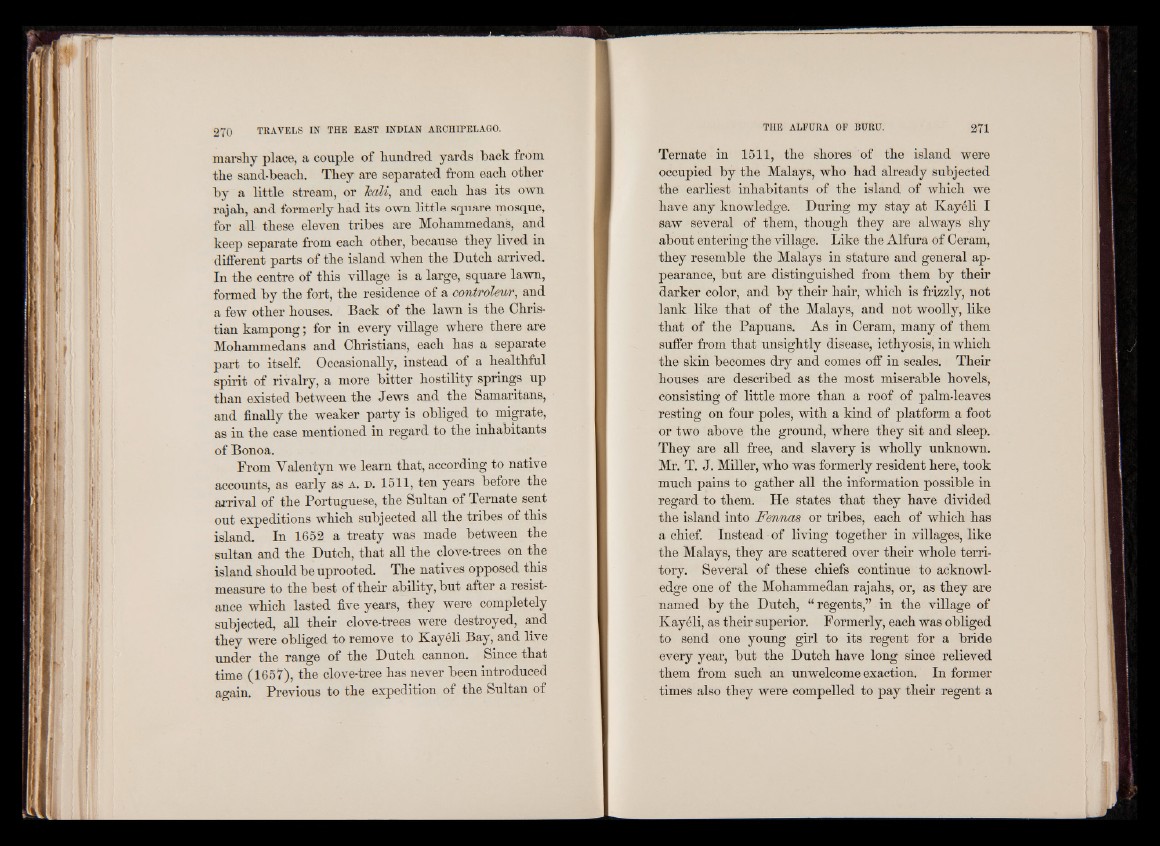
marshy place, a couple of hundred yards back from
the sand-beach. They are separated from each other
by a little stream, or Tcali, and each has its own
rajah, and formerly had its own little square mosque,
for all these eleven tribes are Mohammedans, and
keep separate from each other, because they lived in
different parts of the island when the Dutch arrived.
In the centre of this village is a large, square lawn,
formed by the fort, the residence of a controlmr, and
a few other houses. Back of the lawn is the Christian
kampong; for in every village where there are
Mohammedans and Christians, each has a separate
part to itself. Occasionally, instead of a healthful
spirit of rivalry, a more bitter hostility springs up
than existed between the Jews and the Samaritans,
and finally the weaker party is obliged to migrate,
as in the case mentioned in regard to the inhabitants
of Bonoa.
From Yalentyn we learn that, according to native
accounts, as early as a . d . 1511, ten years before the
arrival of the Portuguese, the Sultan of Ternate sent
out expeditions which subjected all the tribes of this
island. In 1652 a treaty was made between the
sultan and the Dutch, that all the clove-trees on the
island should be uprooted. The natives opposed this
measure to the best of their ability, but after a resistance
which lasted five years, they were completely
subjected, all their clove-trees were destroyed, and
they were obliged to remove to Kayeli Bay, and live
under the range of the Dutch cannon. Since that
time (1657), the clove-tree has never been introduced
again. Previous to the expedition of the Sultan of
Ternate in 1511, the shores of the island were
occupied by the Malays, who had already subjected
the earliest inhabitants of the island of which we
have any knowledge. During my stay at Kayeli I
saw several of them, though they are always shy
about entering the village. Like the Alfura of Ceram,
they resemble the Malays in stature and general appearance,
but are distinguished from them by their
darker color, and by their hair, which is frizzly, not
lank like that of the Malays, and not woolly, like
that of the Papuans. As in Ceram, many of them
suffer from that unsightly disease, icthyosis, in which
the skin becomes dry and comes off in scales. Their
houses are described as the most miserable hovels,
consisting of little more than a roof of palm-leaves
resting on four poles, with a kind of platform a foot
or two above the ground, where they sit and sleep.
They are all free, and slavery is wholly unknown.
Mr. T. J. Miller, who was formerly resident here, took
much pains to gather all the information possible in
regard to them. He states that they have divided
the island into Fennas or tribes, each of which has
a chief. Instead of living together in villages, like
the Malays, they are scattered over their whole territory.
Several of these chiefs continue to acknowledge
one of the Mohammedan rajahs, or, as they are
named by the Dutch, “ regents,” in the village of
Kayeli, as their superior. Formerly, each was obliged
to send one young girl to its regent for a bride
every year, but the Dutch have long since relieved
them from such an unwelcome exaction. In former
times also they were compelled to pay their regent a